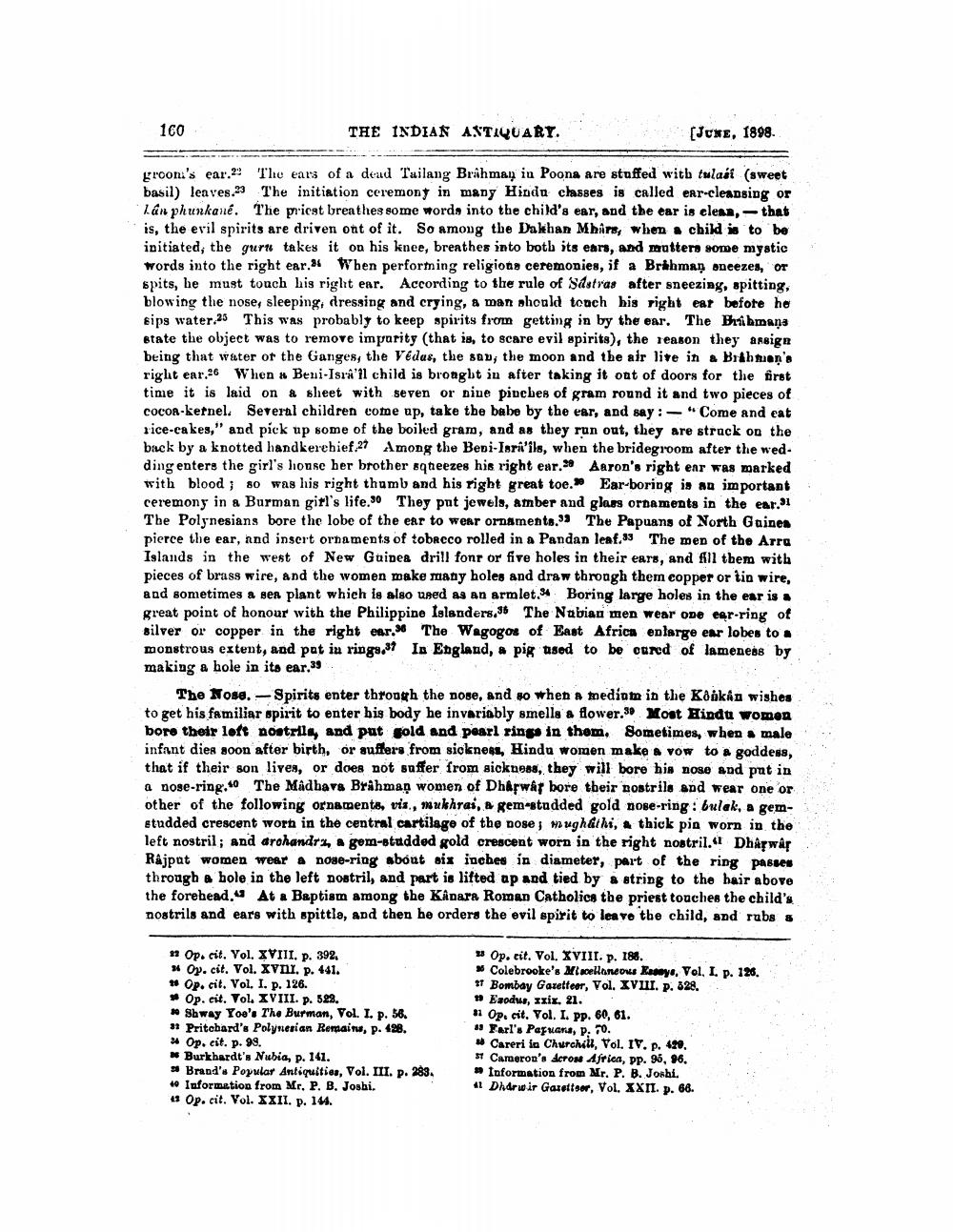________________
100
THE INDIAN AXTIQUART.
(JUNE, 1898
grconi's ear. The ears of a dead Tailang Brahman in Poona are stuffed with tulasi (sweet basil) leaves.23 The initiation ceremony in many Hinda classes is called ear-cleansing or Lan phunkané. The pricat breathes some words into the child's ear, and the ear is elena, -that is, the evil spirits are driven ont of it. So among the Dakhan Mhars, when a child is to be initiated, the gurit takes it on his knee, breathes into both its ears, and mutters some mystic words into the right ear. When performing religions ceremonies, if a Brahman sneezes, or spits, he must touch his right ear. According to the rule of Sastras after sneezing, spitting, blowing the nose, sleeping, dressing and crying, a man should touch his right eat before he sips water.25 This was probably to keep spirits from getting in by the ear. The Bibmaņa state the object was to remove imparity (that is, to scare evil spirits), the reason they ansign being that water of the Ganges, the Vedas, the sov; the moon and the air live in a Brihtuan's right ear.26 When # Beni-Isra'il child is brought in after taking it out of doors for the first time it is laid on & sheet with seven or nine pincbes of gram round it and two pieces of COCOA-kernel. Several children come up, take the babe by the ear, and say: - "Come and eat rice-cakes," and pick up some of the boiled gram, and as they run out, they are strack on the back by a knotted handkerebief.27 Among the Bedi-Isra'ils, when the bridegroom after the wedding enters the girl's lionse her brother squeezes his right ear.2e Aaron's right ear was marked with blood ; 80 was his right thumb and his right great toe. Ear-boring is no important ceremony in a Burman girl's life. They put jewels, amber and glass ornaments in the ear.» The Polynesians bore the lobe of the ear to wear ornaments." The Papuans of North Gaines pierce the ear, nnd insert ornaments of tobacco rolled in a Pandan leaf. The men of the Arra Islands in the west of New Guinea drill fonr or five holes in their ears, and all them with pieces of brass wire, and the women make many holes and draw through them copper or tin wire, and sometimes a ser plant which is also waed as an armlet. Boring large holes in the ear is a great point of honour with the Philippine Islanders,36 The Nubian men wear one ear-ring of silver or copper in the right ear. The Wagogos of East Africa enlarge ear lobes to a monstrous extent, and put in rings,37 In England, a pig tisod to be oured of lameness by making a hole in its ear.39.
The Nose. - Spirits enter through the nose, and so when a medium in the Kookan wishes to get his familiar spirit to enter his body he invariably smells a flower.30 Most Hindu women bore their loft nostrils, and put gold and pearl rings in them. Sometimes, when male infant dies soon after birth, or suffers from sickness, Hindu women make a vow to a goddess, that if their son lives, or does not suffer from sicknes, they will bore his nose and put in a nose-ring,40 The Madhava Brahman women of Dharwar bore their nostrils and wear one or other of the following ornaments, vis., mukhrai, a gem-studded gold nose-ring: bulak, a gemetudded crescent worn in the central cartilage of the nose; mughathi, thick pin worn in the left nostril; and drohandra, a gom-studded gold crescent worn in the right nostril. Dharwar Rajpat women wear a nose-ring about six inches in diameter, part of the ring passes through a hole in the left nostril, and part is lifted up and tied by a string to the hair above the forehead. At a Baptism among the Kinara Roman Catholica the priest touches the child's nostrils and ears with spittle, and then he orders the evil spirit to leave the child, and rubs s
12 Op. cit. Vol. XVIII. p. 392. * Op. cit, Vol. XVII. p. 441.
Op. cit. Vol. I. p. 126.
Op. cit. Tol XVIII. p. 529. # Shway Yoe's The Burman, Vol. I. p. 56. * Pritchard's Polynerian Remaitu, P. 128. * Op. cit. p. 98. * Burkhardt's Nubia, p. 141. * Brand's Popular Antiquities, Vol. III. p. 283. 40 Information from Mr. P. B. Joshi. u Op. cit. Vol. XXII. p. 144.
» Op. cit. Vol. XVIII. p. 186. » Colebrooke's Miscellaneous Kemaye, Vol. I. p. 128. 37 Bombay Gazetteer, Vol. XVIII. p. 328. # Exodus, xxix. 21. . 31 Op. cit. Vol. I. PP. 60, 61. # Farl's Pafuard, p. 70. # Careri in Churchill, Vol. IV. p. 420. 37 Cameron's Acron Africa, pp. 95, 96. # Information from Mr. P. B. Jorbi. 11 Dharw ir Gazettsor, Vol. XXII. p. 68.




